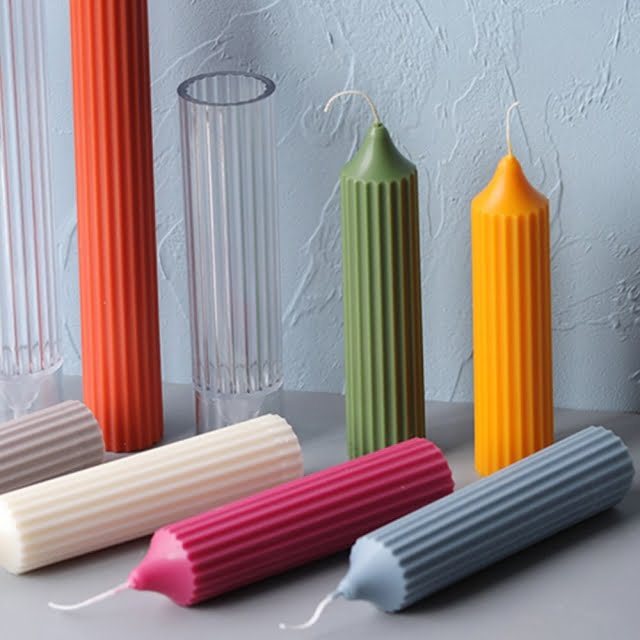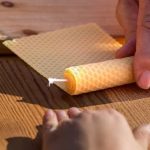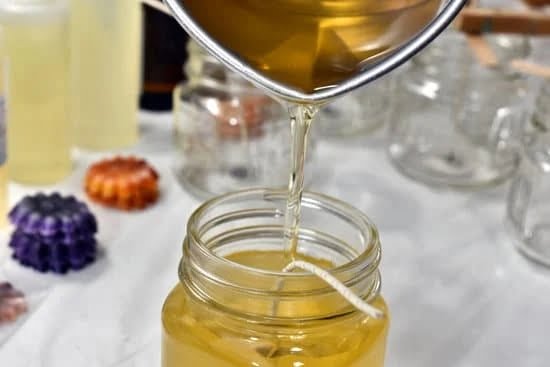Creative projects are important for kids in their development stages, but why not something productive too? Kids making candles provide a unique and enjoyable experience that has several benefits. Not only can kids get their creative juices flowing, but they also gain valuable practical skills. From working with melting wax and learning the science of mixology to the creation of unique and artistic designs, there is plenty to be learnt from kids making candles.
Physical Benefits: A Learning Experience Kids making candles provides them with an excellent opportunity to learn about physical processes. From the basics of handling hot wax without getting burned, to more advanced concepts such as understanding how essential oils work with beeswax and soy wax and the ability to customize fragrances, kids can explore a range of chemical reactions through this creative activity.
It is a great way for little ones to learn about evaporation, condensation, solubility and other scientific elements related to candle-making.
Emotional Benefits: Building Self-Confidence Engaging in projects like candle-making gives children a sense of accomplishment when they see their creations come alive. The idea that they have been able to make something beautiful and useful from raw materials increases theirthrill and enthusiasm – it boosts their morale and improves their self-confidence.
Participating in this art form will help inspire them during hard times when things may not go as well as planned; creating relatively successful products out of even small amounts of ingredientsthat take teamworkcan give them a springboard into further productivity elsewhere too.
In an increasingly digital era, knowing how to make tangible items that can be enjoyed by others around them brings about a sense of fulfillment for some childrenand serves as an excellent motivation tool for learning new skills.
Projects like kids making candlesempower those partaking in itto express themselves ina tactile way which is incredibly beneficial in developing healthy emotions while reinforcing positive values at the same time.The knowledge gained from these experiences can prove invaluable down the line, so it’s fantastic that families are now seeing the value in encouraging such pursuits even at an early age.
An Introduction to Candle Making with Kids
Candle making with kids is an enjoyable and rewarding activity. Not only are they creative, but it helps teach them a valuable skill. From melting wax to pouring it into molds, the process of making candles is simple, but time consuming. With patience and guidance, kids will learn how to make their own candles in a matter of hours.
What You Will Need
- Paraffin wax or beeswax
- Glass container and double boiler (or microwave)
- Candle dye
- Fragrance or essential oils (optional)
- wick sized for the container
- Mold (optional)
The first step in the candle making process is to melt the paraffin wax. The easiest way to do this is by using a double boiler or in the microwave if you prefer. The glass container should be filled 2/3 of the way with wax and then set into the water-filled larger pot – melt gently until all chunks are gone. Once melted, slowly add dye until your desired color is achieved.
You can also add any essential oils you’d like for fragrance; some popular choices include lavender, jasmine, patchouli and sandalwood. Next, move your molten wax to whichever mold you have chosen: teacups, jelly jars, mason jarsWhatever works best for your project.
Finally, once it has cooled slightly in your mold of choice you will need a wick based on its size – these will come with wick tabs for each type that you can easily attach before placing in the center of your candle.
Once your wick is secure with its tab at the bottom and center of your tin or mold place it safely away from drafty areas as even air movement can cause it to burn unevenly; next comes preparing it for initial burning by allowing it to set until hardened – this could take several hours depending on what shape/size you have decided upon.
When ready slowly light a match while holding wick up straight away from body so not to cause any unfortunate burns; true flame science now enters equation as one must observe how quickly temps rise and adjust accordingly by monitoring how quickly heat dissipates throughout wax giving its unique shine & hue like that found on an artfully crafted painting.
Exploring the Types of Wax for Candle Making with Kids
Most kids love making things with their hands, and candle making for kids offers a great creative activity. There are several different types of waxes available for creating candles with youngsters. Exploring the various wax tools and supplies can not only be educational for the children but also a whole lot of fun.
The most common type of wax used by adults in candle-making is paraffin. Unfortunately, because it has a relatively low melting point, it’s generally not recommended to use this option when working with children. Not only that, but paraffin has been linked to health problems ranging from headaches and asthma to cardiac arrest.
Soy Wax
A good wax option for candle making with kids is soy wax. It’s readily available, simple to work with, safe when melted, and smells cleaner than petroleum-based products like paraffin or beeswax.
To make the process even easier on young learners, manufacturers offer pre-colored cubes or flakes that dissolve quickly and hold scent well. Soy candles are thought to burn longer than other types of candles because its melting point is higher than that of paraffin or other petroleum-based waxes.
Beeswax
Bewswax is another option you may consider when teaching candle making for kids – simply because it’s natural and there’s no need to add hardeners or colors in order to achieve good results when molding it into shapes or containers. Since beeswax has a naturally sweet honey-like smell all on its own – no extra essential oils needed.
Additionally, depending on the desired choice of color – you can also choose between yellow pure beeswax (which comes from fresh bee hives) or white (which goes through a bleaching process). Whichever option you choose however; just remember that one pound of beeswax makes about 20 ounces worth of solid candles.
Palm Wax
Another kind wax popularly used in “do-it-yourself” craft projects is palm wax – which just like soy and Beeswax comes from vegetable oil. It stands apart primarily due to its creamy texture while still managing to hold elegant shapes quite well after cooling down and becoming solid once again after being exposed shortly in hot temperatures.
This kind of wax also doesn’t require any special additives upfront – however if your child is hoping for colored end products they’ll have to ask you ahead of time as there aren’t any dye blocks available yet unlike soybeans.
Showcasing the Science of Candle Making with Kids
Candle making is a great way for kids to gain an understanding of science while creating something beautiful. Not only is candle making fascinating for kids, it allows them to use their creative problem-solving skills combined with exploration in learning about the world around them. Kids can learn a variety of thing from the basics of chemistry to how chemicals combine and create reactions.
The art of candle making begins with an understanding of the four basic components: wax, wick, dyes, and fragrances. Each component plays its own unique role in producing a quality candle. Wax provides structure and flame retardant; the wick provides longevity, dyes give the color and fragrances provide aromatherapy qualities in varying levels.
With the proper guidance, kids can have success in their projects from start to finish. Here are some essential tips on how to get their projects started:
- Choose a scent that complements each season.
- Decide on whether you want an opaque or transparent look in your candles.
- Determine which wax is best suited depending on end product.
- Remember to leave enough room at the top of your container for heat expansion during burning
- Take time when pouring melted wax into containers as this must be done at an appropriate temperature.
Making candles with kids is an enjoyable activity that not only teaches them new skills but also educates them about scientific concepts such as heat conductivity, chemical bonds and flame retardant properties associated with wax. Whether using soybean wax instead of paraffin or substituting essential oils for synthetic fragrance oils – there are plenty of opportunities for growing minds to explore different methods and ingredients.
In addition, this is also seen as an ideal opportunity to introduce young children into light entrepreneurship; if they are willing to commit time into designing unique products they could sell at craft fairs or online stores as a means introducing themselves into business practices early on.
Supplies and Equipment Necessary to Make Candles with Kids
When a child expresses an interest in candle making projects, it is important for the adult or caregiver to provide the correct supplies and equipment. Working with a hot flame can be dangerous if not handled with caution and proper safety protocols are followed. The following list comprises the essential supplies and apparatus for kids making candles:
- Paraffin wax
- A quality thermometer
- Wicks
- A double boiler
- Container (jar, tin, etc.)
- Fragrance oils(optional)
Paraffin wax is used in most candle making projects with kids since it is particularly suitable for younger ones as it has a much lower melting temperature than alternative wax materials. A thermometer should always be kept close to the candle making area to keep an eye on the temperature of melted wax and other elements of the project.
Wicks must also be readily accessible to ensure that all legs of their craft efforts are well thought out from start to finish. Wicks should be secured at the appropriate length before starting any project to avoid having them “float” around in their containers when they heat up during microwaving or boiling.
To melt their chosen wax material, a double boiler should be used to prevent any bottle of paraffin wax from tipping over, ensuring flames will pass over its surface evenly for best results. Furthermore, using a container that keeps its shape during heating will help contain any messy spills so better safety can be achieved throughout your crafting sessions with your little ones.
Adding fragrance oils can add some olfactory joy when working on any candle making project with kids – just make sure you read up on which oils can separate from melted wax during cooling and pick ones that maintain mixed consistency once cooled for greater toxin-free security.
Great Ideas for Decorating Candles with Kids
Taking advantage of the wonderful activity of making candles with kids can be a fun and rewarding experience. Having children participate in this creative process is an amazing opportunity to learn a practical skill while also connecting and bonding. Here are some great ideas for decorating their homemade candles:
- Painting: Painting on candles offers a variety of possibilities, from vibrant colors to unique designs. Children can practice their freehand skills or add words and phrases to personalize each candle.
- Glitter: Sprinkle glitter on the top of a cooled wax surface for extra sparkles that will stand out. Glitter is also an excellent way to customize candles for special occasions.
- Flowers & Plants: Decorating with fresh flowers and plants is always a surefire way to delight everyone. Young kids can easily make beautiful pressed flower decorations by picking flowers on outdoor walks for their candles.
- Fabrics & Ribbons: Cut fabric pieces into shapes such as circles, hearts, or stars and stick them onto your candle after it cools off. Attaching ribbons or trinkets complete the look.
Making candles with kids doesn’t have to be complicated. Simple activities like creating stripes on the candle by dripping several colors of dyed wax down its edge, using colorful crayons in circular patterns, adding silver or gold paint highlights into white tinted waxetc., can generate attractive looking decorative pieces that are sure to stimulate any child’s movement toward creativity.
Aside from these techniques, another great approach to adornments is creating scents that evoke pleasant aromas when lit such as citrus scents from oranges or lemons, floral fragrances from essential oils like lavender and geranium, plus other combinations you can dream up together.
Finally, doing hands-on activities like making candles can create memories that last for generations. Involving children in the process not only encourages socialization and cooperation but also fulfills their need for active exploration both unconsciously and consciously due to the tactile and olfactory senses provided through the medium of candle-making craftwork.
So why not take advantage this time-honored activity with your children? You’ll create meaningful memories that you’ll never forget – about all those special experiences shared during moments spent making interesting colored candles together.
Safety Tips for Creating Candles with Kids
Making candles with children can be a fun and educational activity. In order to make it safe, however, there are some safety precautions that must be taken. Here is a list of tips for creating candles with kids in a safe manner:
- Always supervise children when making candles.
- Make sure the area where the work is done is free of clutter and well-lit.
- Be aware of flammable materials around the area, such as rags, fabrics, and papers.
- Be sure to provide protective eyewear and gloves for the children if necessary.
Children should be taught proper techniques when melting candle wax. It’s important that they understand how hot melted wax is and always use caution when handling it. Educate them on applying containers slowly to avoid splatter and keep their distance from open flames. Make sure kids know not to leave the melted wax or its container unattended at any time.
Another important safety measure when working with children is ventilation. Airborne particles from the heated wax may cause breathing problems should they become too concentrated in the air. Consider working outdoors or close by an open window for abundant airflow throughout the entire process.
Finally, provide clear instructions on how to clean up after making candles; this includes disposing of used containers properly in sealed bags or bins before they cool down completely. Kids should also learn how to properly store any unfinished projects correctly by keeping them away from heat sources or other hazards like an open flame kitchen stove, pets, children’s toys, etc.
Allergy-Free Supplies for Candle Making with Kids
Making candles with kids is a great way to teach them important lessons about craftsmanship and self-expression. However, if your child has allergies or asthma, it can be difficult to find candle-making supplies that won’t cause a reaction.
Good news. There are lots of great resources that allow you to make beautiful, safe candles with kids who have allergies or respiratory sensitivities. Here is a list of essential supplies for allergy-free candle making:
- Allergen-free soy or beeswax (not paraffin)
- Dairy-free vegetable shortening
- Reusable and biodegradable cotton wick
- Certified organic dyes
- Fragrance oils without synthetic chemicals
Soy wax is considered an allergen-free option because it is made from hydrogenated oils, which eliminates potential allergens such as palm oil and other natural ingredients. Beeswax is also suitable for those with allergies or asthma because it does not contain any synthetic additives. When selecting soy or beeswax make sure the label reads “natural” to ensure the product does not contain any synthetic chemicals. It always helps to research each supplier before committing to purchase.
When looking for the right wick for allergen free candle making, opt for an unbleached cotton wick in order to avoid potentially irritating dyes and fragrances. These are often easier to find online than in local craft stores as some brands may use chemical agents in their manufacturing process which can be toxic when exposed due to heat while burning a candle.
Always look for different sizes depending on how much wax you need for your projects so get enough wicks that will cover your needs.
Another important thing to remember when looking for ingredients in kid’s crafts is allergens contained within dyes and fragrance oils used in the production. Many natural dyes are actually made out of plants like turmeric root, hibiscus flowers etc., but also careful not to purchase any pre-made dyes that may contain artificial fillers which can trigger reactions even after being exposed through limited contact or inhalation such as sneezing or watery eyes.
Similarly, synthetic fragrances should be avoided when creating candles with sensitive people around because mixing these synthetics can produce harsh irritants into the environment such as strong odors and smoke production, which could aggravate any allergies your children have. Allergens commonly found in fragrance oils include formaldehyde, pthalates and propylene glycol so look out labels carefully before investing time and money into this project.
How to Educate Kids on Scent Making and Color Mixing
Making candles with kids can be a great experience. It allows them to explore their creativity and teach them the basics of scent making and color mixing. Some parents may think that this activity is too complicated, but there are several simple activities you can do to get started.
Choosing Scents
A fun way for children to learn about scents is by using essential oils. You can create an at-home DIY station where both you and your child pick out two or three different essential oils that they find intriguing. This will help guide your child on how to mix different fragrances together to make a more unique scent and broaden their knowledge of nose making in a safe, fun way.
Creating Colours
You also could set up an area that offers various liquid candle dyes of various colours. Allow your child to explore different colour combinations until they are happy with the results. Have the materials available, such as beakers, measuring spoons, stirrers, and separate containers for each dye colour needed so they feel confident throughout their experiment.
- Steps:
- Choose two or three essential oils.
- Gather necessary items (beaker, measuring spoon).
- Select colours of choice
- Mix chosen options while stirring.
- Test result.
Reflections on the Joys/Benefits of Kids Making Candles
Making candles with kids can be a very rewarding activity. It is an easy and fun way to get the younger generations excited about crafting, while also learning core concepts of chemistry, geography, history, and more. Not to mention the satisfaction of seeing their hard work come to fruition.
One of the greatest advantages of kids making candles is that it teaches them responsibility. Making your own candlestick is no easy task; and in order to complete the task successfully, one must carefully follow instructions, pay attention to details, and be patient throughout the process.
A beautifully crafted candle is something that requires concentration and determination; skills which will help when children encounter more complex activities in life. Making candles with the whole family can also be an opportunity for parents to bond with their children because each child’s contribution is required for a finished project.
For a successful craft project involving kids, providing them with quality products and ingredients can make or break the experience. Using beeswax as opposed to paraffin wax allows for thinner wicks as well as a larger range of aromas thanks to its naturally occurring beeswax scent.
While making candles might not always result in attractive creations at first due to inexperience or carelessness, most imperfections can usually be remedied with some extra heat and clever scents such first time failures can be seen at a learning experience rather than defeats.
The immediate gratification from the creative activity of making candles can engage both children’s minds and bodies throughout the entire process – from melting wax allthe way through finally holds their own creations in their hands. Watchingchildren participate in this interesting activity encourages sensory-motor development – allowingthemFine motor use when pouring molten wax into molds, improving hand eye coordination when threading wicks into place – which boostsmore confidence after they create something they are proud of bytheir efforts.

Welcome to my candle making blog! In this blog, I will be sharing my tips and tricks for making candles. I will also be sharing some of my favorite recipes.





